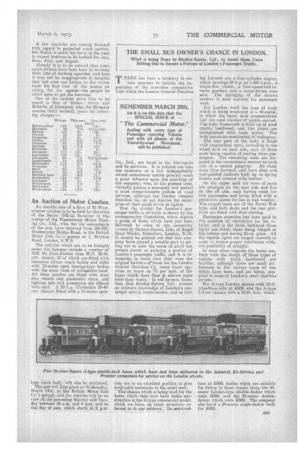THE SMALL BUS OWNER'S CHANCE IN LONDON.
Page 19

If you've noticed an error in this article please click here to report it so we can fix it.
What is being Done by Straker-Squire, Ltd., to Assist those Users Setting Out to Secure a Portion of London's Passenger Traffic.
THERE has been a tendency in certain quarters to belittle the importance of the motorbus competition with which the London General Omnibus
.Co., Ltd., are faced in the Metropolis and its environs. It. is pointed out that the existence of a few independently owned motorbuses cannot poss.bly exert a great influence upon the activities of the company, who, at. the present time, virtually possess a. monopoly and control a most comprehensive system of road services, although the London Genera" Omnibus Co. do not dismiss the enterprise of their small, rivals so lightly.
That the rivalry for London's passenger traffic is no myth is shown by the accompanying iRustration, which depicts a group of busts which have just been -delivered to some of the competing owners by Straker-Squire, Ltd., of Angel Road Works, Edmonton, London, N.18. It should be pointed out that this company have played a notable pelt in setting out to meet the needs of small bus owners intent, on securing a portion of London's passenger traffic, and it is
interesting to learn that they were the original builders of 'buses for the London General Omnibus Co. many years ago, when as many as 75 per cent. of the buses which were then in service came from their works. It will be seen. therefore, that Straker-Squire, Ltd.. possess an intimate knowledge of London's passenger service requirements, and as such
they are in an excellent position to give invaluable assistance to the small man.
The chassis which is being used for the buses which they now have under eonstruction is the A-type commercial model, which we have, on many occasions, referred to in our columns. Its euestand
ing features are a four•cylinder engine, which develops. 54 h.p. at 1,000 r.p.m., single-disc clutch, a four-speed-and.reverse gearbox, and a worm-driven rear axle. The springing of the chassis renders it most suitable for passenger work.
For London work the type of body which is being employed is a 44-seater, in which the upper deck accommodates half the total number of people carried. The bode framework is built up of good quality hardwood, and the joints are strengthened with body plates. The body panels are constructed of mahogany.
The rear part of the body is fitted with longitudinal seats, extending to the wheel arch on each side, each of these stets being capable of seating three passengers. The remaining seats are disposed in the conventional manner on each side of a central gangway. All these seats face forward, and have deep and well-padded cushions built up on spring frames and covered with leather.
On the upper deck six rows of seats are arranged on the near side and five .rM the off side, each having room for two passengers and being fitted with a protective apron for use In had weathei. The outside seats are of the Never Wet type, and both decks and the rear platform are fitted with floor slatting.
Particular attention has been paid to the question of ventilation for the Interior, and in the front bulkhead three lights are fitted, these being hinged at the bottom and having 21-oz. glass. All the topside lights are hinged centrally in order to ensure proper ventilation without possibility of draught.
In most other respects the buses conform with the design of those types of vehicle with which Londoners are familiar, although there are small differences in the various types of bue which have been, and are being, supplied to some of London's small onanibue owners.
The A-type London chassis with 15-ft. wheelbase sells at £880, and the A-type 3.5-ton chassis with a 14-ft. 6-in. wheel base at £850, bodies which are suitable for fitting to these chassis being the 44seater London-type double-decker which costs £500, and the 54-seater doubledecker which costs £500. The company also build a 34-seater single-decker body for £450.




























